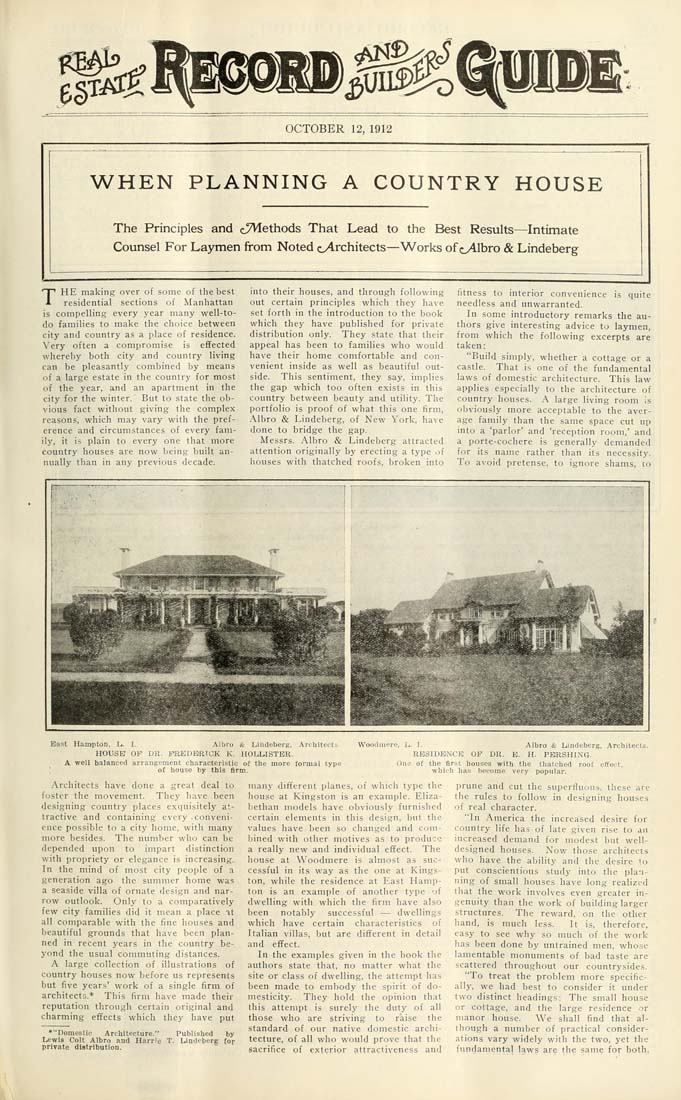Columbia University Libraries Digital Collections: The Real Estate Record
Use your browser's Print function to print these pages.
Real estate record and builders' guide: [v. 90, no. 2326]: October 12, 1912

Text version:
Please note: this text may be incomplete. For more information about this OCR, view About OCR text.
OCTOBER 12, 1912 WHEN PLANNING A COUNTRY HOUSE The Principles and cTWethods That Lead to the Best Results—Intimate Counsel For La5mien from Noted cArchitects—Works of c^llbro & Lindeberg THE making over of some of the best residential sections of Manhattan is compelling every year many well-to- do families to make the choice between city and country as a place of residence. Very often a compromise is effected whereby both city and country living can be pleasantly combined by means of a large estate in the country for most of the year, and an apartment in the city for the winter. But to state the ob¬ vious fact without giving the complex reasons, which may vary with the pref¬ erence and circumstances of every fam¬ ily, it is plain to every one that more country houses are now being built an¬ nually than in any previous decade. into their houses, and through following out certain principles which they have set forth in the introduction to the book which they have published for private distribution only. They state that their appeal has been to families who would have their home comfortable and con¬ venient inside as well as beautiful out¬ side. This sentiment, they say, implies the gap which too often exists in this country between beauty and utility. The portfolio is proof of what this one firm, Albro & Lindeberg, of New York, have done to bridge the gap. Messrs. Albro & Lindeberg attracted attention originally by erecting a type .jf houses with thatched roofs, broken into fitness to interior convenience is quite needless and unwarranted. In some introductory remarks the au¬ thors give interesting advice to laymen, from which the following excerpts are taken: "Build simply, whether a cottage or a castle. That is one of the fundamental laws of domestic architecture. This law applies especially to the architecture of country houses. A large living room is obviously more acceptable to the aver¬ age family than the same space cut up into a 'parlor' and 'reception room,' and a porte-cochere is generally demanded for its name rather than its necessitj'. To avoid pretense, to ignore shams, to Bast Hampton, L. I. Albro & Lindeberg, Architects HOUiSB OP DR. PREDBRIOK K. HOLLISTE«. A well balanced arrangement characteristic of the more formal type ot house by this firm. Woodmere, L. I. Albro & Lindeberg, ArchitecU. RESIDENCE OP DR. B. H. PEJRSHING. One ot the first houses with the thatched root effect, whicli has become very popular. Architects have done a great deal to foster the movement. They have been designing country places exquisitely at¬ tractive and containing every .conveni¬ ence possible to a city home, with many more besides. The number who can be depended upon to impart distinction with propriety or elegance is increasing. In the mind of most city people of a generation ago the summer home was a seaside villa of ornate design and nar¬ row outlook. Only to a comparatively few city families did it mean a place ^t all comparable with the fine houses and beautiful grounds that have been plan¬ ned in recent years in the country be- j'ond the usual commuting distances. A large collection of illustrations of country houses now before us represents but five years' work of a single firm of architects.* This firm have made their reputation through certain original and charming effects which they have put •"Domestic Architecture." Published by Lewis Colt Albro and Harrie T. Lindeberg for private distribution. many different planes, of which type the house at Kingston is an example. Eliza¬ bethan models have obviously furnished certain elements in this design, but the values have been so changed and com¬ bined with other motives as to produce a really new and individual effect. The house at Woodmere is almost as suc¬ cessful in its way as the one at Kings¬ ton, while the residence at East Hamp¬ ton is an example of another type of dwelling with which the firm have also been notably successful — dwellings which have certain characteristics of Italian villas, but are different in detail and effect. In the examples given in the book the authors state that, no matter what the site or class of dwelling, the attempt has been made to embody the spirit of do¬ mesticity. They hold the opinion that this attempt is surely the duty of all those who are striving to raise the standard of our native domestic archi¬ tecture, of all who would prove that the sacrifice of exterior attractiveness and prune and cut the superfluous, these are the rules to follow in designing houses of real character. "In America the increased desire for country life has of late given rise to an increased demand for modest but well- designed houses. Now those architects who have the ability and the desire lo put conscientious study into the plan¬ ning of small houses have long realized that the work involves even greater in¬ genuity than the work of building larger structures. The reward, on the other hand, is much less. It is, therefore, easy to see why so much of the work lias been done by untrained men, whose lamentable monuments of bad taste are scattered throughout our countrysides. "To treat the problem more specific¬ ally, we had best to consider it under two distinct headings: The small house or cottage, and the large residence or manor house. We shall find that al¬ though a number of practical consider¬ ations vary widely with the two, yet the fundamental laws are the same for both.